Reputation Management Plan for Toyota Motor Corporation - 2017
VerifiedAdded on 2020/04/07
|11
|3188
|55
Report
AI Summary
This report provides an in-depth analysis of Toyota Motor Corporation's reputation management plan, specifically focusing on the 2010 recall crisis. The paper begins with an executive summary and background information, followed by a situation analysis that examines the crisis. It defines corporate reputation and reviews relevant literature, exploring the extent of corporate reputation from a stakeholder's viewpoint. The report delves into the impact of the crisis on Toyota's image and the strategies employed to regain customer trust. It examines the use of traditional and social media, as well as the importance of organizational identity and image. The analysis includes a qualitative examination of Toyota's public statements to identify key themes and assess the effectiveness of its communication strategies. The report concludes with recommendations for future reputation management, emphasizing the importance of proactive measures and consistent messaging to maintain a positive brand image. The paper highlights the significance of corporate reputation as a key intangible asset and its connection to competitive success, offering insights into how organizations can navigate crises and protect their reputations.
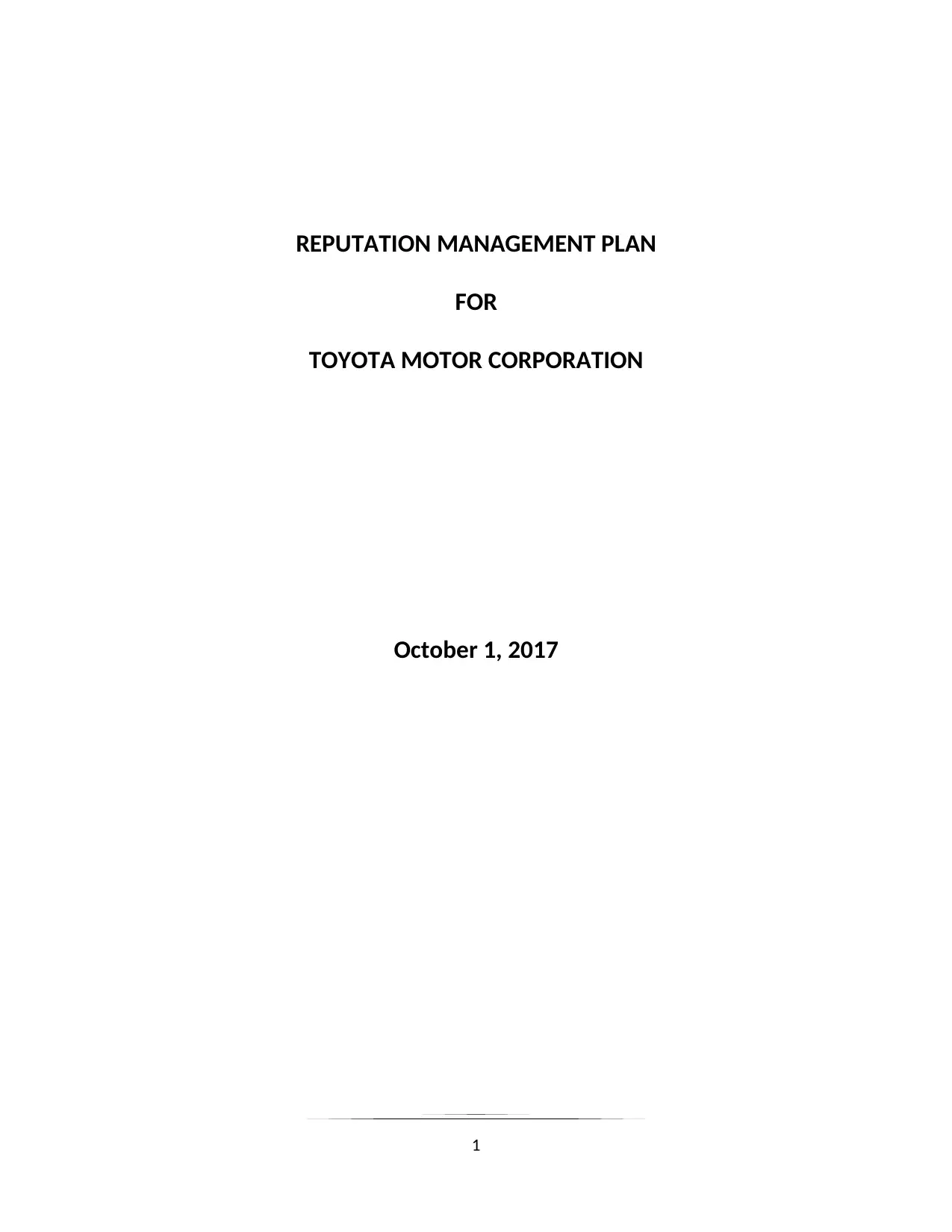
REPUTATION MANAGEMENT PLAN
FOR
TOYOTA MOTOR CORPORATION
October 1, 2017
1
FOR
TOYOTA MOTOR CORPORATION
October 1, 2017
1
Paraphrase This Document
Need a fresh take? Get an instant paraphrase of this document with our AI Paraphraser
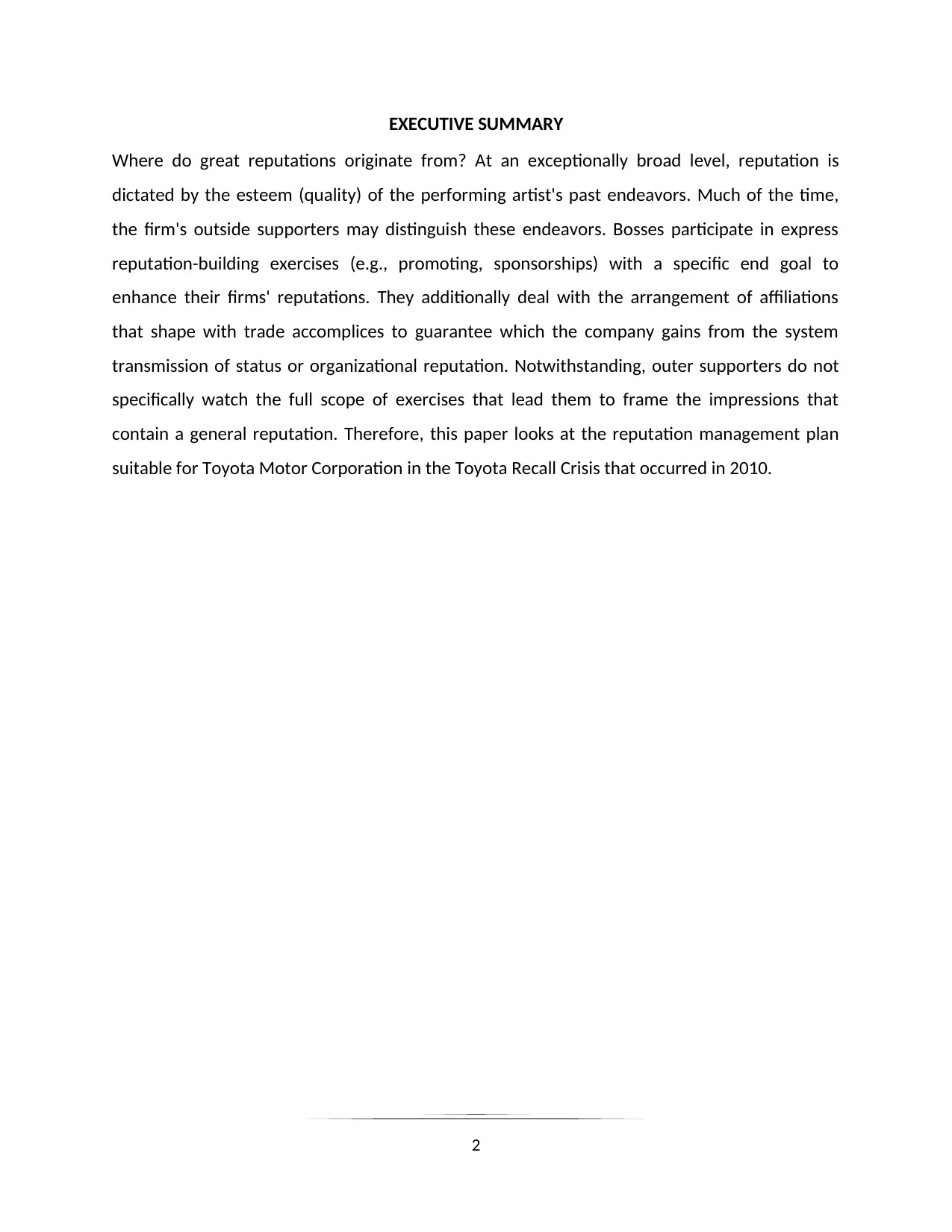
EXECUTIVE SUMMARY
Where do great reputations originate from? At an exceptionally broad level, reputation is
dictated by the esteem (quality) of the performing artist's past endeavors. Much of the time,
the firm's outside supporters may distinguish these endeavors. Bosses participate in express
reputation-building exercises (e.g., promoting, sponsorships) with a specific end goal to
enhance their firms' reputations. They additionally deal with the arrangement of affiliations
that shape with trade accomplices to guarantee which the company gains from the system
transmission of status or organizational reputation. Notwithstanding, outer supporters do not
specifically watch the full scope of exercises that lead them to frame the impressions that
contain a general reputation. Therefore, this paper looks at the reputation management plan
suitable for Toyota Motor Corporation in the Toyota Recall Crisis that occurred in 2010.
2
Where do great reputations originate from? At an exceptionally broad level, reputation is
dictated by the esteem (quality) of the performing artist's past endeavors. Much of the time,
the firm's outside supporters may distinguish these endeavors. Bosses participate in express
reputation-building exercises (e.g., promoting, sponsorships) with a specific end goal to
enhance their firms' reputations. They additionally deal with the arrangement of affiliations
that shape with trade accomplices to guarantee which the company gains from the system
transmission of status or organizational reputation. Notwithstanding, outer supporters do not
specifically watch the full scope of exercises that lead them to frame the impressions that
contain a general reputation. Therefore, this paper looks at the reputation management plan
suitable for Toyota Motor Corporation in the Toyota Recall Crisis that occurred in 2010.
2
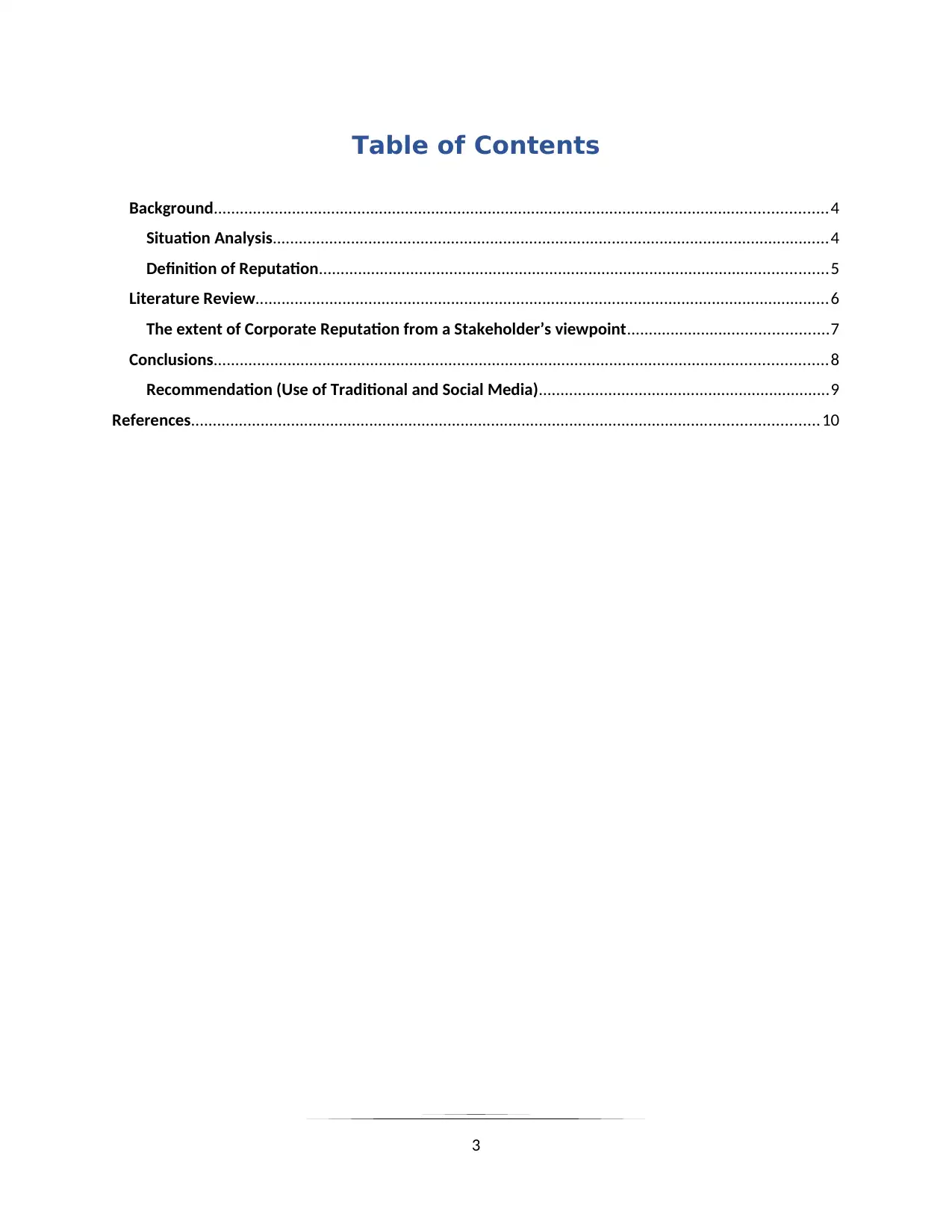
Table of Contents
Background.............................................................................................................................................4
Situation Analysis................................................................................................................................4
Definition of Reputation.....................................................................................................................5
Literature Review....................................................................................................................................6
The extent of Corporate Reputation from a Stakeholder’s viewpoint..............................................7
Conclusions.............................................................................................................................................8
Recommendation (Use of Traditional and Social Media)...................................................................9
References................................................................................................................................................10
3
Background.............................................................................................................................................4
Situation Analysis................................................................................................................................4
Definition of Reputation.....................................................................................................................5
Literature Review....................................................................................................................................6
The extent of Corporate Reputation from a Stakeholder’s viewpoint..............................................7
Conclusions.............................................................................................................................................8
Recommendation (Use of Traditional and Social Media)...................................................................9
References................................................................................................................................................10
3
⊘ This is a preview!⊘
Do you want full access?
Subscribe today to unlock all pages.

Trusted by 1+ million students worldwide
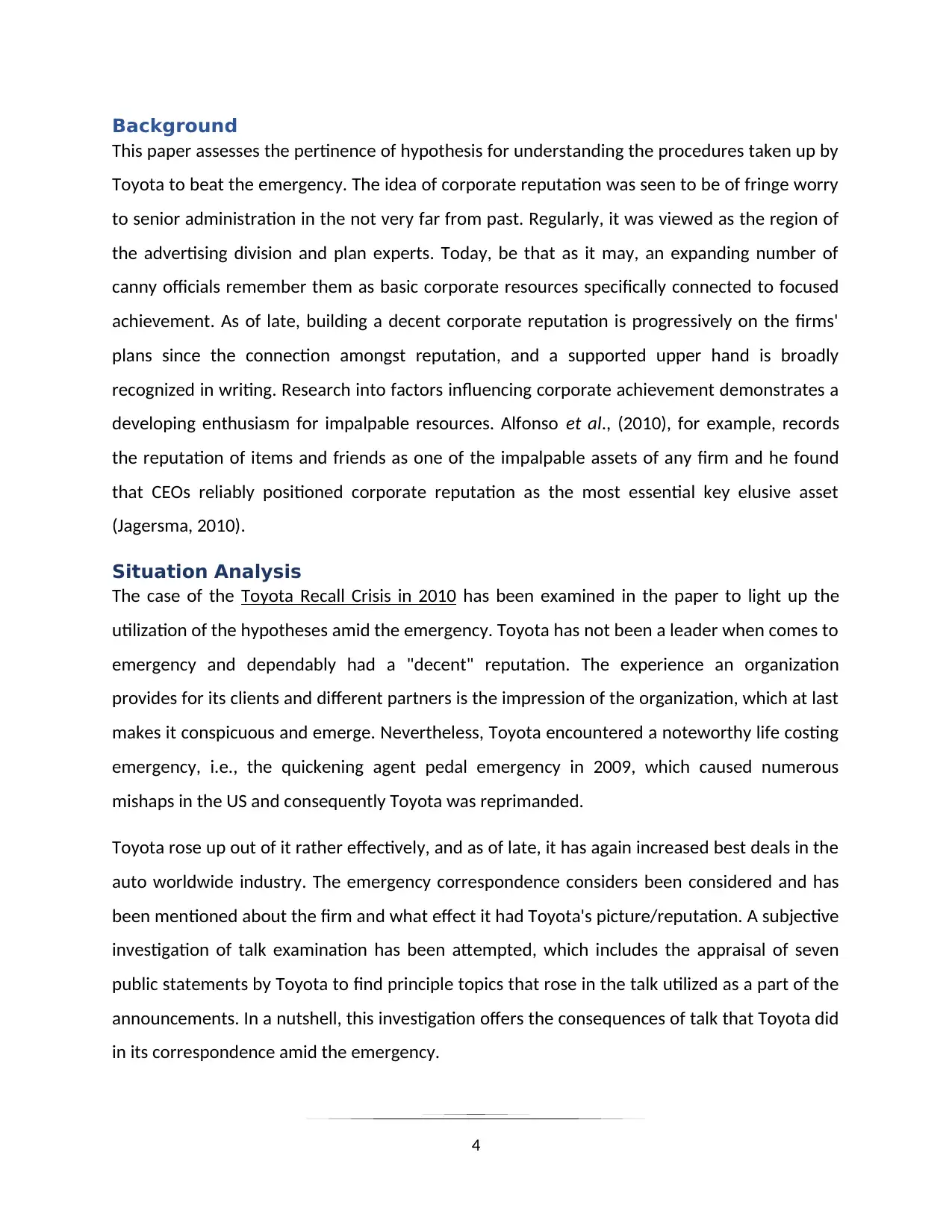
Background
This paper assesses the pertinence of hypothesis for understanding the procedures taken up by
Toyota to beat the emergency. The idea of corporate reputation was seen to be of fringe worry
to senior administration in the not very far from past. Regularly, it was viewed as the region of
the advertising division and plan experts. Today, be that as it may, an expanding number of
canny officials remember them as basic corporate resources specifically connected to focused
achievement. As of late, building a decent corporate reputation is progressively on the firms'
plans since the connection amongst reputation, and a supported upper hand is broadly
recognized in writing. Research into factors influencing corporate achievement demonstrates a
developing enthusiasm for impalpable resources. Alfonso et al., (2010), for example, records
the reputation of items and friends as one of the impalpable assets of any firm and he found
that CEOs reliably positioned corporate reputation as the most essential key elusive asset
(Jagersma, 2010).
Situation Analysis
The case of the Toyota Recall Crisis in 2010 has been examined in the paper to light up the
utilization of the hypotheses amid the emergency. Toyota has not been a leader when comes to
emergency and dependably had a "decent" reputation. The experience an organization
provides for its clients and different partners is the impression of the organization, which at last
makes it conspicuous and emerge. Nevertheless, Toyota encountered a noteworthy life costing
emergency, i.e., the quickening agent pedal emergency in 2009, which caused numerous
mishaps in the US and consequently Toyota was reprimanded.
Toyota rose up out of it rather effectively, and as of late, it has again increased best deals in the
auto worldwide industry. The emergency correspondence considers been considered and has
been mentioned about the firm and what effect it had Toyota's picture/reputation. A subjective
investigation of talk examination has been attempted, which includes the appraisal of seven
public statements by Toyota to find principle topics that rose in the talk utilized as a part of the
announcements. In a nutshell, this investigation offers the consequences of talk that Toyota did
in its correspondence amid the emergency.
4
This paper assesses the pertinence of hypothesis for understanding the procedures taken up by
Toyota to beat the emergency. The idea of corporate reputation was seen to be of fringe worry
to senior administration in the not very far from past. Regularly, it was viewed as the region of
the advertising division and plan experts. Today, be that as it may, an expanding number of
canny officials remember them as basic corporate resources specifically connected to focused
achievement. As of late, building a decent corporate reputation is progressively on the firms'
plans since the connection amongst reputation, and a supported upper hand is broadly
recognized in writing. Research into factors influencing corporate achievement demonstrates a
developing enthusiasm for impalpable resources. Alfonso et al., (2010), for example, records
the reputation of items and friends as one of the impalpable assets of any firm and he found
that CEOs reliably positioned corporate reputation as the most essential key elusive asset
(Jagersma, 2010).
Situation Analysis
The case of the Toyota Recall Crisis in 2010 has been examined in the paper to light up the
utilization of the hypotheses amid the emergency. Toyota has not been a leader when comes to
emergency and dependably had a "decent" reputation. The experience an organization
provides for its clients and different partners is the impression of the organization, which at last
makes it conspicuous and emerge. Nevertheless, Toyota encountered a noteworthy life costing
emergency, i.e., the quickening agent pedal emergency in 2009, which caused numerous
mishaps in the US and consequently Toyota was reprimanded.
Toyota rose up out of it rather effectively, and as of late, it has again increased best deals in the
auto worldwide industry. The emergency correspondence considers been considered and has
been mentioned about the firm and what effect it had Toyota's picture/reputation. A subjective
investigation of talk examination has been attempted, which includes the appraisal of seven
public statements by Toyota to find principle topics that rose in the talk utilized as a part of the
announcements. In a nutshell, this investigation offers the consequences of talk that Toyota did
in its correspondence amid the emergency.
4
Paraphrase This Document
Need a fresh take? Get an instant paraphrase of this document with our AI Paraphraser
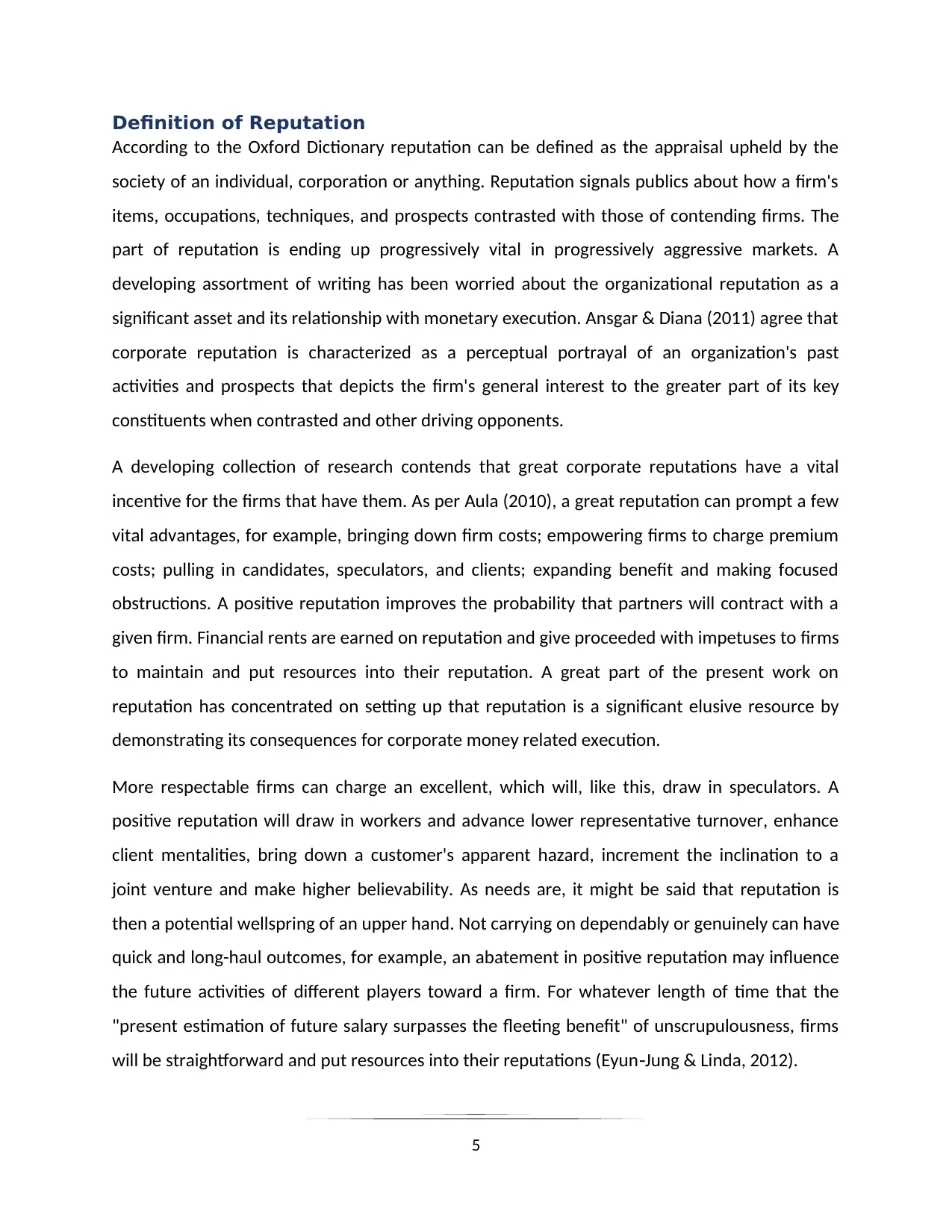
Definition of Reputation
According to the Oxford Dictionary reputation can be defined as the appraisal upheld by the
society of an individual, corporation or anything. Reputation signals publics about how a firm's
items, occupations, techniques, and prospects contrasted with those of contending firms. The
part of reputation is ending up progressively vital in progressively aggressive markets. A
developing assortment of writing has been worried about the organizational reputation as a
significant asset and its relationship with monetary execution. Ansgar & Diana (2011) agree that
corporate reputation is characterized as a perceptual portrayal of an organization's past
activities and prospects that depicts the firm's general interest to the greater part of its key
constituents when contrasted and other driving opponents.
A developing collection of research contends that great corporate reputations have a vital
incentive for the firms that have them. As per Aula (2010), a great reputation can prompt a few
vital advantages, for example, bringing down firm costs; empowering firms to charge premium
costs; pulling in candidates, speculators, and clients; expanding benefit and making focused
obstructions. A positive reputation improves the probability that partners will contract with a
given firm. Financial rents are earned on reputation and give proceeded with impetuses to firms
to maintain and put resources into their reputation. A great part of the present work on
reputation has concentrated on setting up that reputation is a significant elusive resource by
demonstrating its consequences for corporate money related execution.
More respectable firms can charge an excellent, which will, like this, draw in speculators. A
positive reputation will draw in workers and advance lower representative turnover, enhance
client mentalities, bring down a customer's apparent hazard, increment the inclination to a
joint venture and make higher believability. As needs are, it might be said that reputation is
then a potential wellspring of an upper hand. Not carrying on dependably or genuinely can have
quick and long-haul outcomes, for example, an abatement in positive reputation may influence
the future activities of different players toward a firm. For whatever length of time that the
"present estimation of future salary surpasses the fleeting benefit" of unscrupulousness, firms
will be straightforward and put resources into their reputations (Eyun Jung & Linda, 2012).‐
5
According to the Oxford Dictionary reputation can be defined as the appraisal upheld by the
society of an individual, corporation or anything. Reputation signals publics about how a firm's
items, occupations, techniques, and prospects contrasted with those of contending firms. The
part of reputation is ending up progressively vital in progressively aggressive markets. A
developing assortment of writing has been worried about the organizational reputation as a
significant asset and its relationship with monetary execution. Ansgar & Diana (2011) agree that
corporate reputation is characterized as a perceptual portrayal of an organization's past
activities and prospects that depicts the firm's general interest to the greater part of its key
constituents when contrasted and other driving opponents.
A developing collection of research contends that great corporate reputations have a vital
incentive for the firms that have them. As per Aula (2010), a great reputation can prompt a few
vital advantages, for example, bringing down firm costs; empowering firms to charge premium
costs; pulling in candidates, speculators, and clients; expanding benefit and making focused
obstructions. A positive reputation improves the probability that partners will contract with a
given firm. Financial rents are earned on reputation and give proceeded with impetuses to firms
to maintain and put resources into their reputation. A great part of the present work on
reputation has concentrated on setting up that reputation is a significant elusive resource by
demonstrating its consequences for corporate money related execution.
More respectable firms can charge an excellent, which will, like this, draw in speculators. A
positive reputation will draw in workers and advance lower representative turnover, enhance
client mentalities, bring down a customer's apparent hazard, increment the inclination to a
joint venture and make higher believability. As needs are, it might be said that reputation is
then a potential wellspring of an upper hand. Not carrying on dependably or genuinely can have
quick and long-haul outcomes, for example, an abatement in positive reputation may influence
the future activities of different players toward a firm. For whatever length of time that the
"present estimation of future salary surpasses the fleeting benefit" of unscrupulousness, firms
will be straightforward and put resources into their reputations (Eyun Jung & Linda, 2012).‐
5
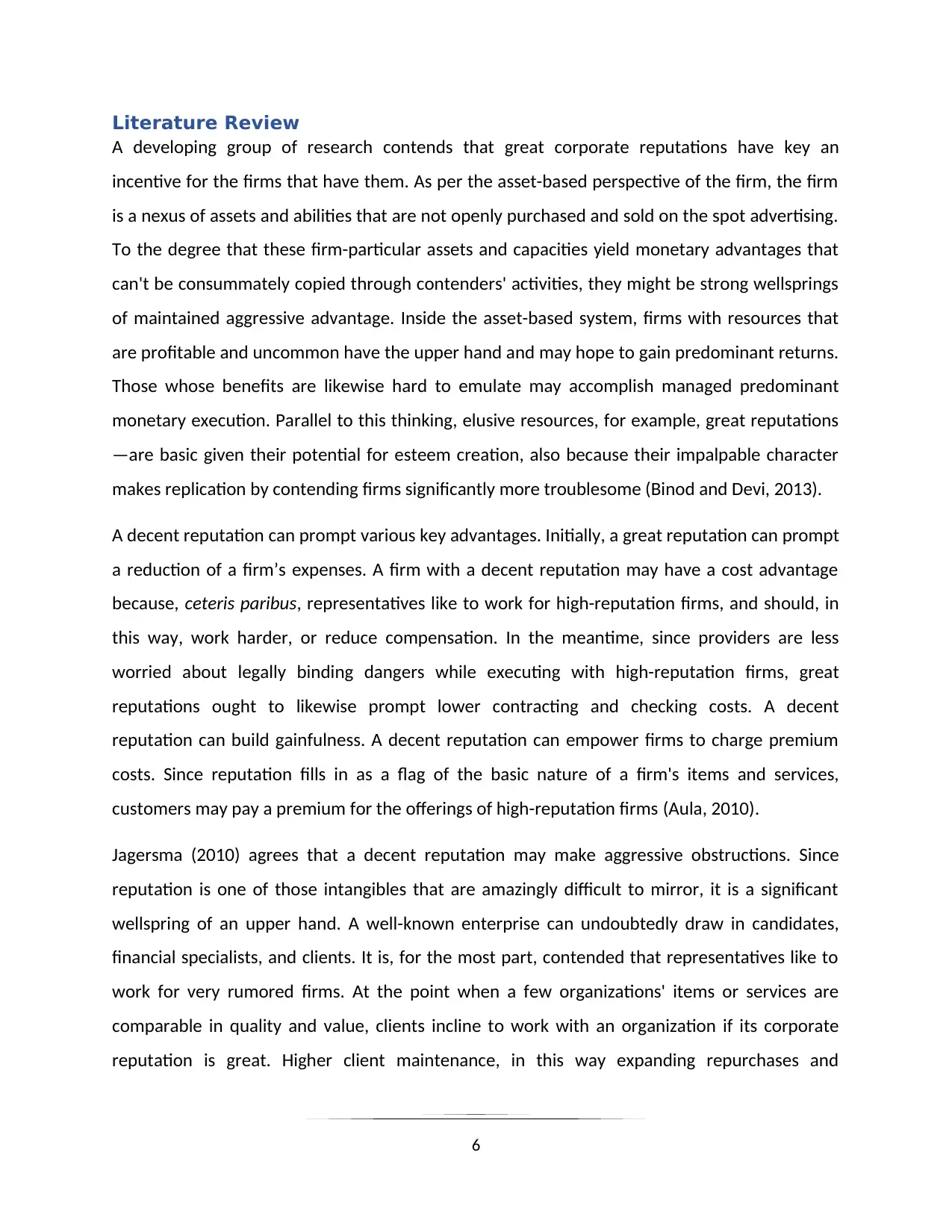
Literature Review
A developing group of research contends that great corporate reputations have key an
incentive for the firms that have them. As per the asset-based perspective of the firm, the firm
is a nexus of assets and abilities that are not openly purchased and sold on the spot advertising.
To the degree that these firm-particular assets and capacities yield monetary advantages that
can't be consummately copied through contenders' activities, they might be strong wellsprings
of maintained aggressive advantage. Inside the asset-based system, firms with resources that
are profitable and uncommon have the upper hand and may hope to gain predominant returns.
Those whose benefits are likewise hard to emulate may accomplish managed predominant
monetary execution. Parallel to this thinking, elusive resources, for example, great reputations
—are basic given their potential for esteem creation, also because their impalpable character
makes replication by contending firms significantly more troublesome (Binod and Devi, 2013).
A decent reputation can prompt various key advantages. Initially, a great reputation can prompt
a reduction of a firm’s expenses. A firm with a decent reputation may have a cost advantage
because, ceteris paribus, representatives like to work for high-reputation firms, and should, in
this way, work harder, or reduce compensation. In the meantime, since providers are less
worried about legally binding dangers while executing with high-reputation firms, great
reputations ought to likewise prompt lower contracting and checking costs. A decent
reputation can build gainfulness. A decent reputation can empower firms to charge premium
costs. Since reputation fills in as a flag of the basic nature of a firm's items and services,
customers may pay a premium for the offerings of high-reputation firms (Aula, 2010).
Jagersma (2010) agrees that a decent reputation may make aggressive obstructions. Since
reputation is one of those intangibles that are amazingly difficult to mirror, it is a significant
wellspring of an upper hand. A well-known enterprise can undoubtedly draw in candidates,
financial specialists, and clients. It is, for the most part, contended that representatives like to
work for very rumored firms. At the point when a few organizations' items or services are
comparable in quality and value, clients incline to work with an organization if its corporate
reputation is great. Higher client maintenance, in this way expanding repurchases and
6
A developing group of research contends that great corporate reputations have key an
incentive for the firms that have them. As per the asset-based perspective of the firm, the firm
is a nexus of assets and abilities that are not openly purchased and sold on the spot advertising.
To the degree that these firm-particular assets and capacities yield monetary advantages that
can't be consummately copied through contenders' activities, they might be strong wellsprings
of maintained aggressive advantage. Inside the asset-based system, firms with resources that
are profitable and uncommon have the upper hand and may hope to gain predominant returns.
Those whose benefits are likewise hard to emulate may accomplish managed predominant
monetary execution. Parallel to this thinking, elusive resources, for example, great reputations
—are basic given their potential for esteem creation, also because their impalpable character
makes replication by contending firms significantly more troublesome (Binod and Devi, 2013).
A decent reputation can prompt various key advantages. Initially, a great reputation can prompt
a reduction of a firm’s expenses. A firm with a decent reputation may have a cost advantage
because, ceteris paribus, representatives like to work for high-reputation firms, and should, in
this way, work harder, or reduce compensation. In the meantime, since providers are less
worried about legally binding dangers while executing with high-reputation firms, great
reputations ought to likewise prompt lower contracting and checking costs. A decent
reputation can build gainfulness. A decent reputation can empower firms to charge premium
costs. Since reputation fills in as a flag of the basic nature of a firm's items and services,
customers may pay a premium for the offerings of high-reputation firms (Aula, 2010).
Jagersma (2010) agrees that a decent reputation may make aggressive obstructions. Since
reputation is one of those intangibles that are amazingly difficult to mirror, it is a significant
wellspring of an upper hand. A well-known enterprise can undoubtedly draw in candidates,
financial specialists, and clients. It is, for the most part, contended that representatives like to
work for very rumored firms. At the point when a few organizations' items or services are
comparable in quality and value, clients incline to work with an organization if its corporate
reputation is great. Higher client maintenance, in this way expanding repurchases and
6
⊘ This is a preview!⊘
Do you want full access?
Subscribe today to unlock all pages.

Trusted by 1+ million students worldwide
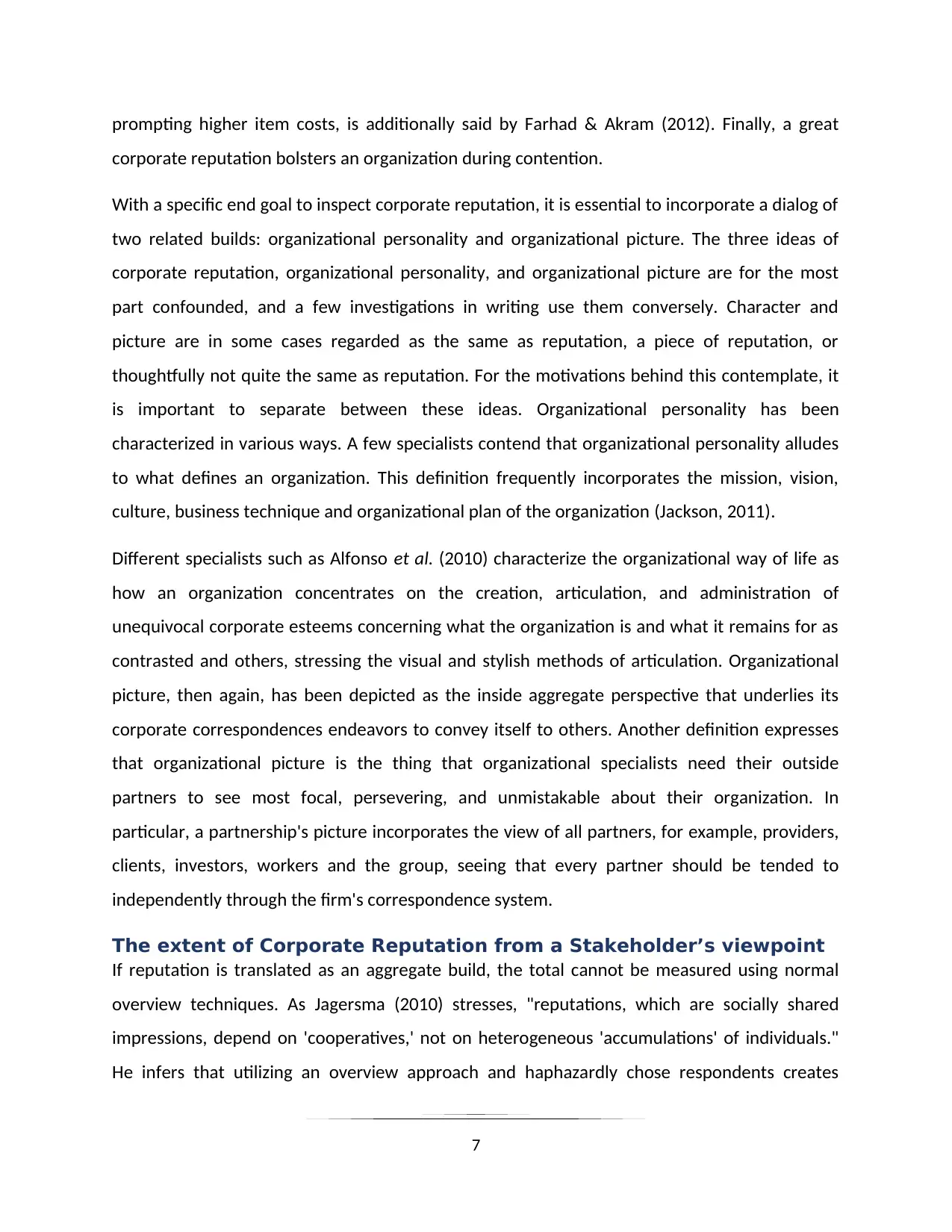
prompting higher item costs, is additionally said by Farhad & Akram (2012). Finally, a great
corporate reputation bolsters an organization during contention.
With a specific end goal to inspect corporate reputation, it is essential to incorporate a dialog of
two related builds: organizational personality and organizational picture. The three ideas of
corporate reputation, organizational personality, and organizational picture are for the most
part confounded, and a few investigations in writing use them conversely. Character and
picture are in some cases regarded as the same as reputation, a piece of reputation, or
thoughtfully not quite the same as reputation. For the motivations behind this contemplate, it
is important to separate between these ideas. Organizational personality has been
characterized in various ways. A few specialists contend that organizational personality alludes
to what defines an organization. This definition frequently incorporates the mission, vision,
culture, business technique and organizational plan of the organization (Jackson, 2011).
Different specialists such as Alfonso et al. (2010) characterize the organizational way of life as
how an organization concentrates on the creation, articulation, and administration of
unequivocal corporate esteems concerning what the organization is and what it remains for as
contrasted and others, stressing the visual and stylish methods of articulation. Organizational
picture, then again, has been depicted as the inside aggregate perspective that underlies its
corporate correspondences endeavors to convey itself to others. Another definition expresses
that organizational picture is the thing that organizational specialists need their outside
partners to see most focal, persevering, and unmistakable about their organization. In
particular, a partnership's picture incorporates the view of all partners, for example, providers,
clients, investors, workers and the group, seeing that every partner should be tended to
independently through the firm's correspondence system.
The extent of Corporate Reputation from a Stakeholder’s viewpoint
If reputation is translated as an aggregate build, the total cannot be measured using normal
overview techniques. As Jagersma (2010) stresses, "reputations, which are socially shared
impressions, depend on 'cooperatives,' not on heterogeneous 'accumulations' of individuals."
He infers that utilizing an overview approach and haphazardly chose respondents creates
7
corporate reputation bolsters an organization during contention.
With a specific end goal to inspect corporate reputation, it is essential to incorporate a dialog of
two related builds: organizational personality and organizational picture. The three ideas of
corporate reputation, organizational personality, and organizational picture are for the most
part confounded, and a few investigations in writing use them conversely. Character and
picture are in some cases regarded as the same as reputation, a piece of reputation, or
thoughtfully not quite the same as reputation. For the motivations behind this contemplate, it
is important to separate between these ideas. Organizational personality has been
characterized in various ways. A few specialists contend that organizational personality alludes
to what defines an organization. This definition frequently incorporates the mission, vision,
culture, business technique and organizational plan of the organization (Jackson, 2011).
Different specialists such as Alfonso et al. (2010) characterize the organizational way of life as
how an organization concentrates on the creation, articulation, and administration of
unequivocal corporate esteems concerning what the organization is and what it remains for as
contrasted and others, stressing the visual and stylish methods of articulation. Organizational
picture, then again, has been depicted as the inside aggregate perspective that underlies its
corporate correspondences endeavors to convey itself to others. Another definition expresses
that organizational picture is the thing that organizational specialists need their outside
partners to see most focal, persevering, and unmistakable about their organization. In
particular, a partnership's picture incorporates the view of all partners, for example, providers,
clients, investors, workers and the group, seeing that every partner should be tended to
independently through the firm's correspondence system.
The extent of Corporate Reputation from a Stakeholder’s viewpoint
If reputation is translated as an aggregate build, the total cannot be measured using normal
overview techniques. As Jagersma (2010) stresses, "reputations, which are socially shared
impressions, depend on 'cooperatives,' not on heterogeneous 'accumulations' of individuals."
He infers that utilizing an overview approach and haphazardly chose respondents creates
7
Paraphrase This Document
Need a fresh take? Get an instant paraphrase of this document with our AI Paraphraser
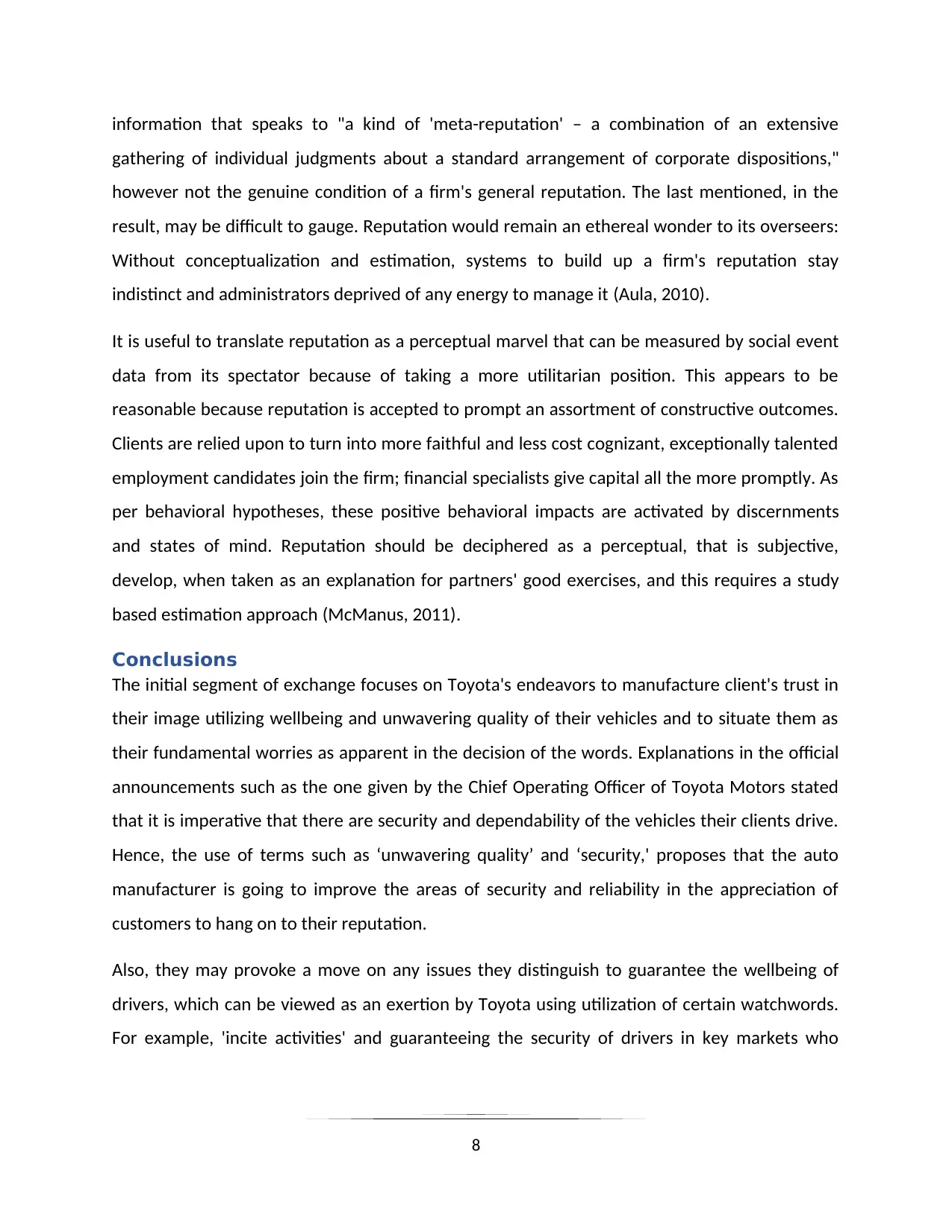
information that speaks to "a kind of 'meta-reputation' – a combination of an extensive
gathering of individual judgments about a standard arrangement of corporate dispositions,"
however not the genuine condition of a firm's general reputation. The last mentioned, in the
result, may be difficult to gauge. Reputation would remain an ethereal wonder to its overseers:
Without conceptualization and estimation, systems to build up a firm's reputation stay
indistinct and administrators deprived of any energy to manage it (Aula, 2010).
It is useful to translate reputation as a perceptual marvel that can be measured by social event
data from its spectator because of taking a more utilitarian position. This appears to be
reasonable because reputation is accepted to prompt an assortment of constructive outcomes.
Clients are relied upon to turn into more faithful and less cost cognizant, exceptionally talented
employment candidates join the firm; financial specialists give capital all the more promptly. As
per behavioral hypotheses, these positive behavioral impacts are activated by discernments
and states of mind. Reputation should be deciphered as a perceptual, that is subjective,
develop, when taken as an explanation for partners' good exercises, and this requires a study
based estimation approach (McManus, 2011).
Conclusions
The initial segment of exchange focuses on Toyota's endeavors to manufacture client's trust in
their image utilizing wellbeing and unwavering quality of their vehicles and to situate them as
their fundamental worries as apparent in the decision of the words. Explanations in the official
announcements such as the one given by the Chief Operating Officer of Toyota Motors stated
that it is imperative that there are security and dependability of the vehicles their clients drive.
Hence, the use of terms such as ‘unwavering quality’ and ‘security,' proposes that the auto
manufacturer is going to improve the areas of security and reliability in the appreciation of
customers to hang on to their reputation.
Also, they may provoke a move on any issues they distinguish to guarantee the wellbeing of
drivers, which can be viewed as an exertion by Toyota using utilization of certain watchwords.
For example, 'incite activities' and guaranteeing the security of drivers in key markets who
8
gathering of individual judgments about a standard arrangement of corporate dispositions,"
however not the genuine condition of a firm's general reputation. The last mentioned, in the
result, may be difficult to gauge. Reputation would remain an ethereal wonder to its overseers:
Without conceptualization and estimation, systems to build up a firm's reputation stay
indistinct and administrators deprived of any energy to manage it (Aula, 2010).
It is useful to translate reputation as a perceptual marvel that can be measured by social event
data from its spectator because of taking a more utilitarian position. This appears to be
reasonable because reputation is accepted to prompt an assortment of constructive outcomes.
Clients are relied upon to turn into more faithful and less cost cognizant, exceptionally talented
employment candidates join the firm; financial specialists give capital all the more promptly. As
per behavioral hypotheses, these positive behavioral impacts are activated by discernments
and states of mind. Reputation should be deciphered as a perceptual, that is subjective,
develop, when taken as an explanation for partners' good exercises, and this requires a study
based estimation approach (McManus, 2011).
Conclusions
The initial segment of exchange focuses on Toyota's endeavors to manufacture client's trust in
their image utilizing wellbeing and unwavering quality of their vehicles and to situate them as
their fundamental worries as apparent in the decision of the words. Explanations in the official
announcements such as the one given by the Chief Operating Officer of Toyota Motors stated
that it is imperative that there are security and dependability of the vehicles their clients drive.
Hence, the use of terms such as ‘unwavering quality’ and ‘security,' proposes that the auto
manufacturer is going to improve the areas of security and reliability in the appreciation of
customers to hang on to their reputation.
Also, they may provoke a move on any issues they distinguish to guarantee the wellbeing of
drivers, which can be viewed as an exertion by Toyota using utilization of certain watchwords.
For example, 'incite activities' and guaranteeing the security of drivers in key markets who
8
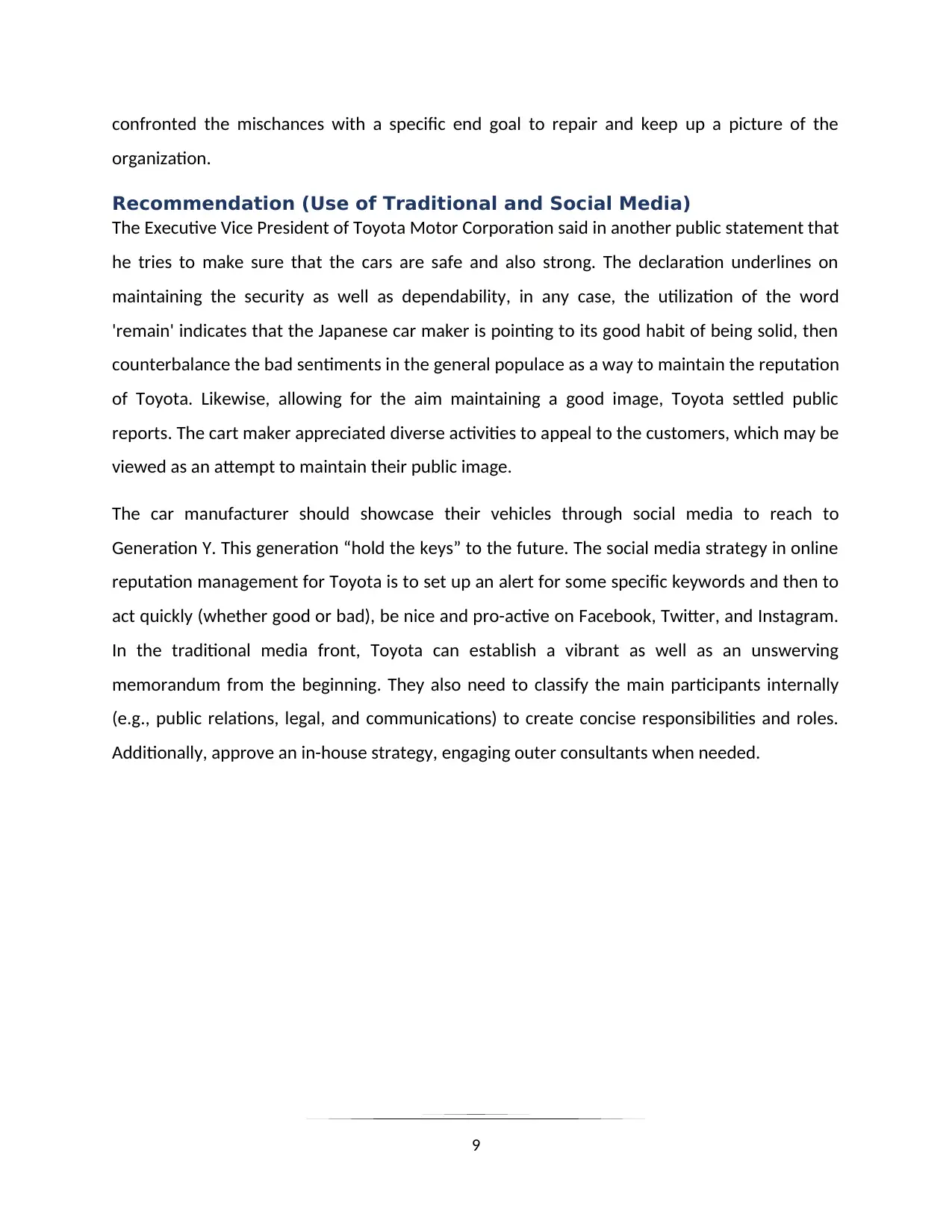
confronted the mischances with a specific end goal to repair and keep up a picture of the
organization.
Recommendation (Use of Traditional and Social Media)
The Executive Vice President of Toyota Motor Corporation said in another public statement that
he tries to make sure that the cars are safe and also strong. The declaration underlines on
maintaining the security as well as dependability, in any case, the utilization of the word
'remain' indicates that the Japanese car maker is pointing to its good habit of being solid, then
counterbalance the bad sentiments in the general populace as a way to maintain the reputation
of Toyota. Likewise, allowing for the aim maintaining a good image, Toyota settled public
reports. The cart maker appreciated diverse activities to appeal to the customers, which may be
viewed as an attempt to maintain their public image.
The car manufacturer should showcase their vehicles through social media to reach to
Generation Y. This generation “hold the keys” to the future. The social media strategy in online
reputation management for Toyota is to set up an alert for some specific keywords and then to
act quickly (whether good or bad), be nice and pro-active on Facebook, Twitter, and Instagram.
In the traditional media front, Toyota can establish a vibrant as well as an unswerving
memorandum from the beginning. They also need to classify the main participants internally
(e.g., public relations, legal, and communications) to create concise responsibilities and roles.
Additionally, approve an in-house strategy, engaging outer consultants when needed.
9
organization.
Recommendation (Use of Traditional and Social Media)
The Executive Vice President of Toyota Motor Corporation said in another public statement that
he tries to make sure that the cars are safe and also strong. The declaration underlines on
maintaining the security as well as dependability, in any case, the utilization of the word
'remain' indicates that the Japanese car maker is pointing to its good habit of being solid, then
counterbalance the bad sentiments in the general populace as a way to maintain the reputation
of Toyota. Likewise, allowing for the aim maintaining a good image, Toyota settled public
reports. The cart maker appreciated diverse activities to appeal to the customers, which may be
viewed as an attempt to maintain their public image.
The car manufacturer should showcase their vehicles through social media to reach to
Generation Y. This generation “hold the keys” to the future. The social media strategy in online
reputation management for Toyota is to set up an alert for some specific keywords and then to
act quickly (whether good or bad), be nice and pro-active on Facebook, Twitter, and Instagram.
In the traditional media front, Toyota can establish a vibrant as well as an unswerving
memorandum from the beginning. They also need to classify the main participants internally
(e.g., public relations, legal, and communications) to create concise responsibilities and roles.
Additionally, approve an in-house strategy, engaging outer consultants when needed.
9
⊘ This is a preview!⊘
Do you want full access?
Subscribe today to unlock all pages.

Trusted by 1+ million students worldwide
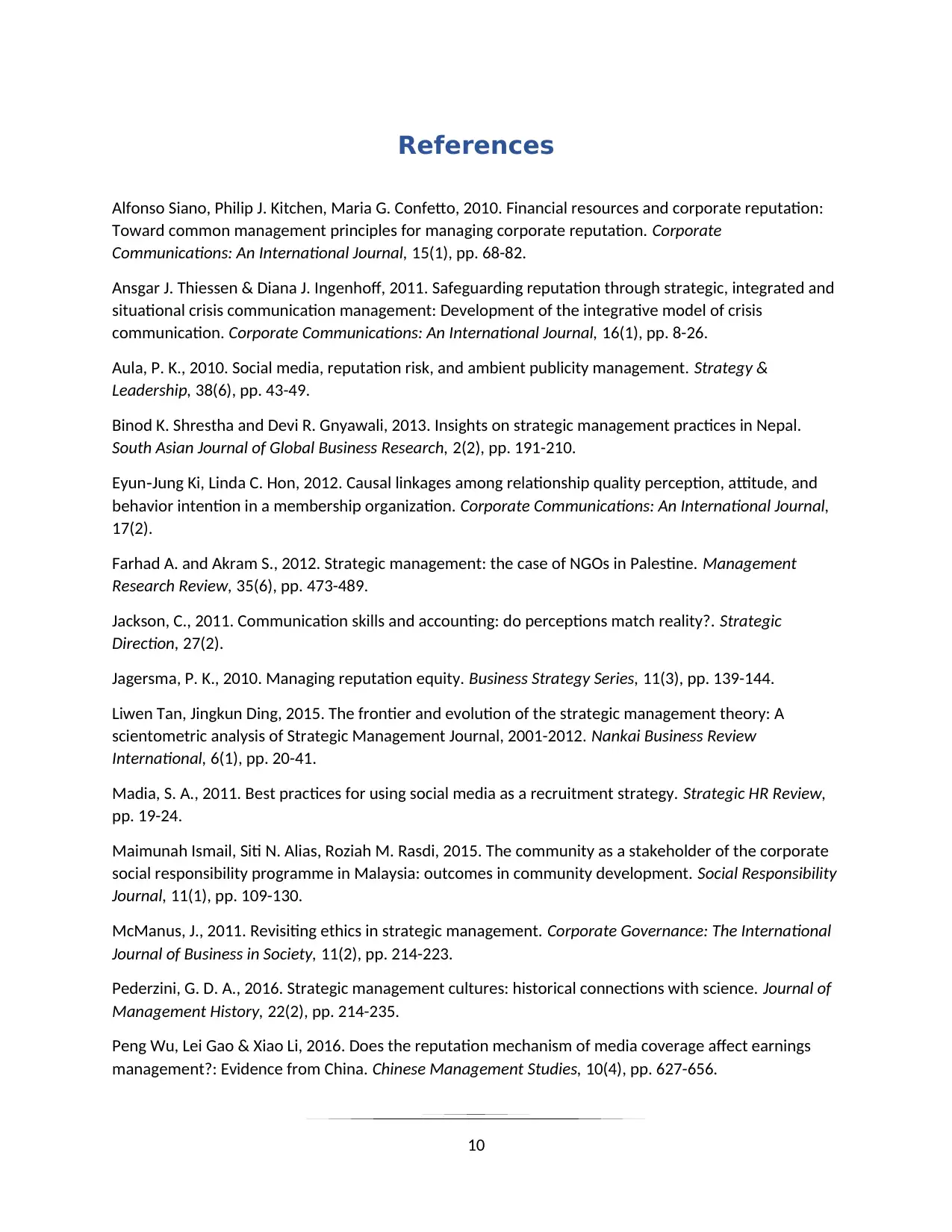
References
Alfonso Siano, Philip J. Kitchen, Maria G. Confetto, 2010. Financial resources and corporate reputation:
Toward common management principles for managing corporate reputation. Corporate
Communications: An International Journal, 15(1), pp. 68-82.
Ansgar J. Thiessen & Diana J. Ingenhoff, 2011. Safeguarding reputation through strategic, integrated and
situational crisis communication management: Development of the integrative model of crisis
communication. Corporate Communications: An International Journal, 16(1), pp. 8-26.
Aula, P. K., 2010. Social media, reputation risk, and ambient publicity management. Strategy &
Leadership, 38(6), pp. 43-49.
Binod K. Shrestha and Devi R. Gnyawali, 2013. Insights on strategic management practices in Nepal.
South Asian Journal of Global Business Research, 2(2), pp. 191-210.
Eyun Jung Ki, Linda C. Hon, 2012. Causal linkages among relationship quality perception, attitude, and‐
behavior intention in a membership organization. Corporate Communications: An International Journal,
17(2).
Farhad A. and Akram S., 2012. Strategic management: the case of NGOs in Palestine. Management
Research Review, 35(6), pp. 473-489.
Jackson, C., 2011. Communication skills and accounting: do perceptions match reality?. Strategic
Direction, 27(2).
Jagersma, P. K., 2010. Managing reputation equity. Business Strategy Series, 11(3), pp. 139-144.
Liwen Tan, Jingkun Ding, 2015. The frontier and evolution of the strategic management theory: A
scientometric analysis of Strategic Management Journal, 2001-2012. Nankai Business Review
International, 6(1), pp. 20-41.
Madia, S. A., 2011. Best practices for using social media as a recruitment strategy. Strategic HR Review,
pp. 19-24.
Maimunah Ismail, Siti N. Alias, Roziah M. Rasdi, 2015. The community as a stakeholder of the corporate
social responsibility programme in Malaysia: outcomes in community development. Social Responsibility
Journal, 11(1), pp. 109-130.
McManus, J., 2011. Revisiting ethics in strategic management. Corporate Governance: The International
Journal of Business in Society, 11(2), pp. 214-223.
Pederzini, G. D. A., 2016. Strategic management cultures: historical connections with science. Journal of
Management History, 22(2), pp. 214-235.
Peng Wu, Lei Gao & Xiao Li, 2016. Does the reputation mechanism of media coverage affect earnings
management?: Evidence from China. Chinese Management Studies, 10(4), pp. 627-656.
10
Alfonso Siano, Philip J. Kitchen, Maria G. Confetto, 2010. Financial resources and corporate reputation:
Toward common management principles for managing corporate reputation. Corporate
Communications: An International Journal, 15(1), pp. 68-82.
Ansgar J. Thiessen & Diana J. Ingenhoff, 2011. Safeguarding reputation through strategic, integrated and
situational crisis communication management: Development of the integrative model of crisis
communication. Corporate Communications: An International Journal, 16(1), pp. 8-26.
Aula, P. K., 2010. Social media, reputation risk, and ambient publicity management. Strategy &
Leadership, 38(6), pp. 43-49.
Binod K. Shrestha and Devi R. Gnyawali, 2013. Insights on strategic management practices in Nepal.
South Asian Journal of Global Business Research, 2(2), pp. 191-210.
Eyun Jung Ki, Linda C. Hon, 2012. Causal linkages among relationship quality perception, attitude, and‐
behavior intention in a membership organization. Corporate Communications: An International Journal,
17(2).
Farhad A. and Akram S., 2012. Strategic management: the case of NGOs in Palestine. Management
Research Review, 35(6), pp. 473-489.
Jackson, C., 2011. Communication skills and accounting: do perceptions match reality?. Strategic
Direction, 27(2).
Jagersma, P. K., 2010. Managing reputation equity. Business Strategy Series, 11(3), pp. 139-144.
Liwen Tan, Jingkun Ding, 2015. The frontier and evolution of the strategic management theory: A
scientometric analysis of Strategic Management Journal, 2001-2012. Nankai Business Review
International, 6(1), pp. 20-41.
Madia, S. A., 2011. Best practices for using social media as a recruitment strategy. Strategic HR Review,
pp. 19-24.
Maimunah Ismail, Siti N. Alias, Roziah M. Rasdi, 2015. The community as a stakeholder of the corporate
social responsibility programme in Malaysia: outcomes in community development. Social Responsibility
Journal, 11(1), pp. 109-130.
McManus, J., 2011. Revisiting ethics in strategic management. Corporate Governance: The International
Journal of Business in Society, 11(2), pp. 214-223.
Pederzini, G. D. A., 2016. Strategic management cultures: historical connections with science. Journal of
Management History, 22(2), pp. 214-235.
Peng Wu, Lei Gao & Xiao Li, 2016. Does the reputation mechanism of media coverage affect earnings
management?: Evidence from China. Chinese Management Studies, 10(4), pp. 627-656.
10
Paraphrase This Document
Need a fresh take? Get an instant paraphrase of this document with our AI Paraphraser
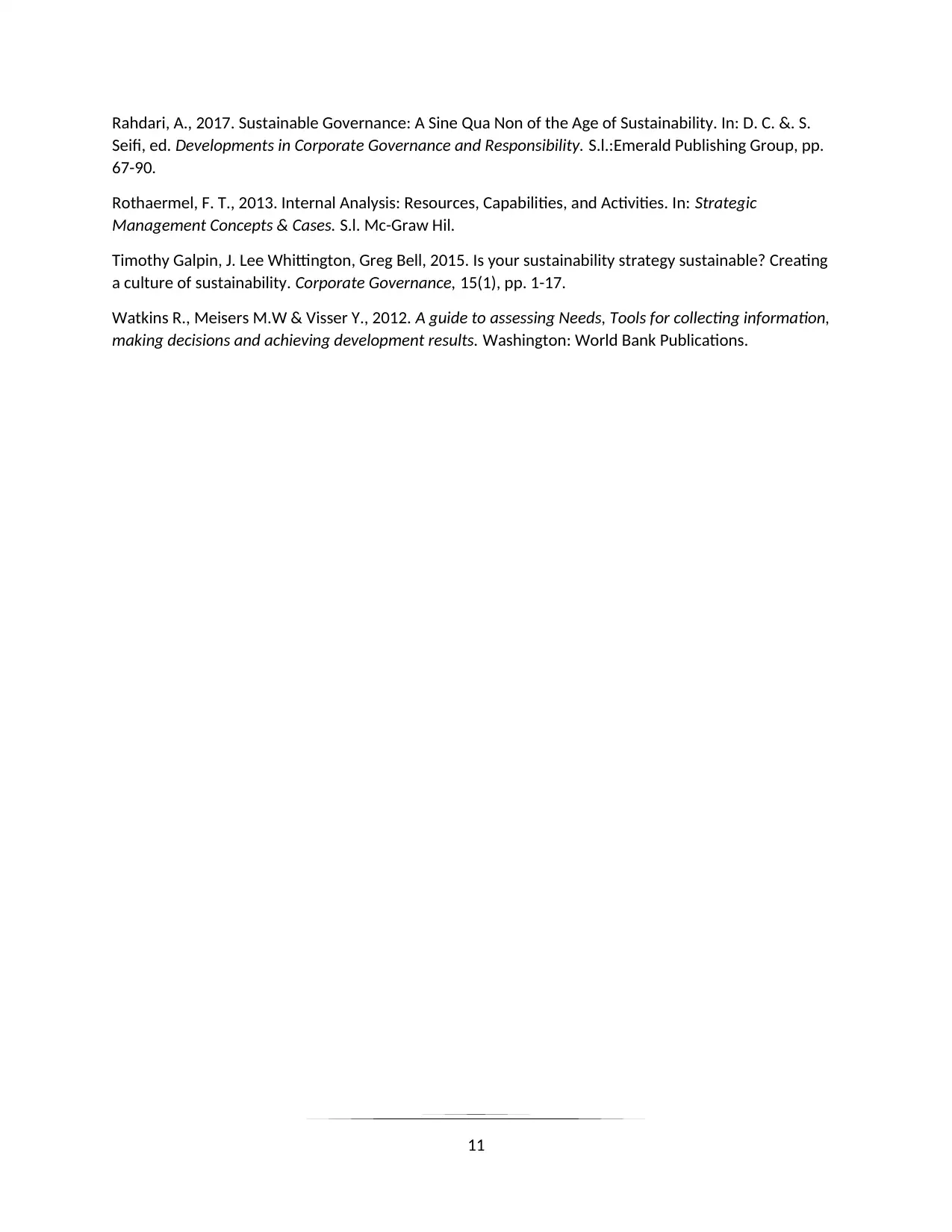
Rahdari, A., 2017. Sustainable Governance: A Sine Qua Non of the Age of Sustainability. In: D. C. &. S.
Seifi, ed. Developments in Corporate Governance and Responsibility. S.l.:Emerald Publishing Group, pp.
67-90.
Rothaermel, F. T., 2013. Internal Analysis: Resources, Capabilities, and Activities. In: Strategic
Management Concepts & Cases. S.l. Mc-Graw Hil.
Timothy Galpin, J. Lee Whittington, Greg Bell, 2015. Is your sustainability strategy sustainable? Creating
a culture of sustainability. Corporate Governance, 15(1), pp. 1-17.
Watkins R., Meisers M.W & Visser Y., 2012. A guide to assessing Needs, Tools for collecting information,
making decisions and achieving development results. Washington: World Bank Publications.
11
Seifi, ed. Developments in Corporate Governance and Responsibility. S.l.:Emerald Publishing Group, pp.
67-90.
Rothaermel, F. T., 2013. Internal Analysis: Resources, Capabilities, and Activities. In: Strategic
Management Concepts & Cases. S.l. Mc-Graw Hil.
Timothy Galpin, J. Lee Whittington, Greg Bell, 2015. Is your sustainability strategy sustainable? Creating
a culture of sustainability. Corporate Governance, 15(1), pp. 1-17.
Watkins R., Meisers M.W & Visser Y., 2012. A guide to assessing Needs, Tools for collecting information,
making decisions and achieving development results. Washington: World Bank Publications.
11
1 out of 11
Your All-in-One AI-Powered Toolkit for Academic Success.
+13062052269
info@desklib.com
Available 24*7 on WhatsApp / Email
![[object Object]](/_next/static/media/star-bottom.7253800d.svg)
Unlock your academic potential
Copyright © 2020–2025 A2Z Services. All Rights Reserved. Developed and managed by ZUCOL.

